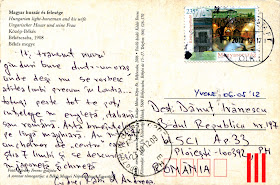Page
▼
January 31, 2013
0491 HUNGARY - A hussar and his wife
The first mention of the Hussarones (in latin) was in documents dating from 1432 in Southern Hungary. According to Webster's, the word hussar stems from the Hungarian huszár, which originates from the Serbian and Croatian husar (pirate), from the Medieval Latin cursarius. According to another theory, the word is derived from the Hungarian húsz (twenty), signifying that 'one in twenty' was selected for service. The hussars originated in bands of mostly Serbian warriors crossing into southern Hungary after the Turkish invasion of Serbia at the end of the 14th century. The Governor of Hungary, the Walachian Iancu de Hunedoara, created mounted units inspired by the Ottomans. His son, Matthias Corvinus, later king of Hungary, is unanimously accepted as the creator of these troops, the first Hussar regiments being the light cavalry of the Black Army of Hungary.
After the king's death, hussars remained the preferred form of cavalry in Hungary, and the Habsburg emperors hired Hungarian hussars as mercenaries. Beginning from the 16th century, more and more European armies had created hussar units, in the 19th century this type of light cavalry reaching even in Latin America. The hussars were allways notable for their colourful and elaborate parade uniforms, but also they had a reputation for being the dashing, if unruly, adventurers of the army. The traditional image of the hussar is of a reckless, hard-drinking, hard-swearing, womanising, moustachioed, swashbuckler. The appearance of the machine gun and later of the tank meant the end of the hussars, but a number of armored or ceremonial mounted units in modern armies retain the designation of hussars.
This photo was taken in 1908, i.e. exactly in the year in which the Austro-Hungarian Army abandoned, gradually and reluctantly, its dashing and colourful uniforms, introducing a new field uniform, in a new and less conspicuous colour: hechtgrau (pike-grey, a grey-lightblue hue). I think that the hussar in the picture (which seems to be officer, due to its large foldable fur collar) wears a field uniform, not a parade one. Noticeable the moustaches, traditional for the European hussars, the high riding boots, and the curved sabre.
And in terms of women's clothes was a transitional period. Victorian era ended recently and clothing was increasingly factory-made and often sold in large, fixed price department stores. New machinery and materials changed clothing in many ways. Anyway, the hussar's wife seems to be modestly dressed, if not even austere.
This postcard is part of a series of six with a special story, about which I wrote here. The stamps belong to the series Health Tourism - Spas, about which I wrote here.
References
Hussar - Wikipedia
Austro-Hungarian Army uniforms in WW1 - Landships
Les Hussards - Hussards Photos
senders: Petrică Sîrbu, Andreea Dolete and Marian Irimia
sent from Budapest (Hungary), on 19.10.2012


This comment has been removed by the author.
ReplyDeleteEin interessanter Artikel. Ich habe was gelernt. Danke!
Delete